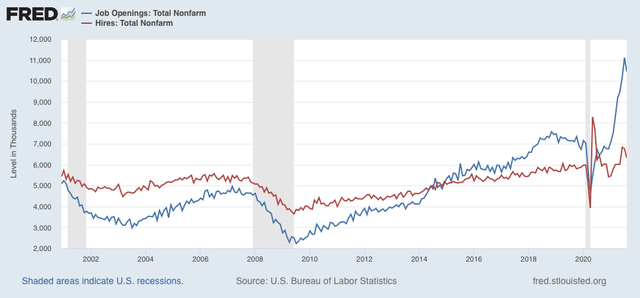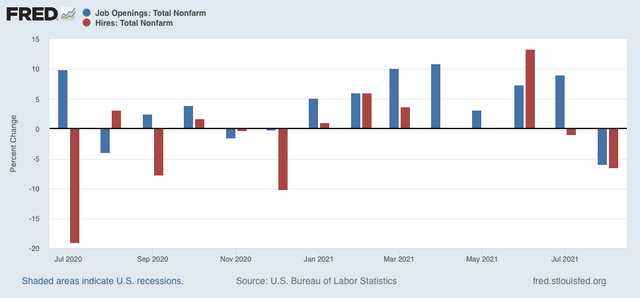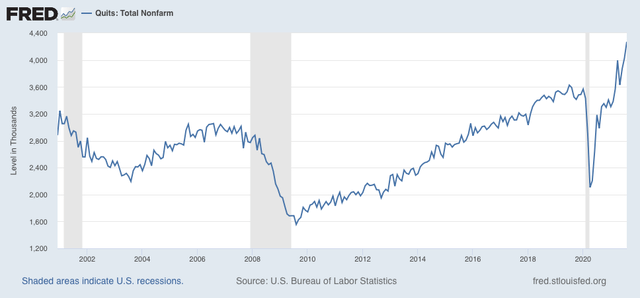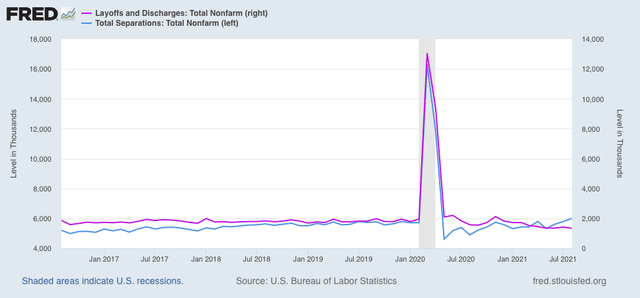August JOLTS report: progress towards a new jobs equilibrium? This morning’s JOLTS report covers August, which you may recall featured a disappointing jobs report (since revised somewhat higher ), during which the Delta wave was growing to its worst levels, and two months after a number of GOP-controlled States terminated enhanced unemployment benefits, on the theory that they were excessive and were coddling idle workers. Despite this, last month we did not see a big drop in unfilled job openings. This month we did – but we saw a big decline in actual hires, too. Job openings decreased 659,000 to 10.349 million (blue in the graph below), while actual hiring (red) also decreased 439,000 to 6.322 million : Here are the month over month
Topics:
NewDealdemocrat considers the following as important: jobs equililibrium, new jobs, US EConomics
This could be interesting, too:
NewDealdemocrat writes JOLTS revisions from Yesterday’s Report
Bill Haskell writes The North American Automobile Industry Waits for Trump and the Gov. to Act
Bill Haskell writes Families Struggle Paying for Child Care While Working
Joel Eissenberg writes Time for Senate Dems to stand up against Trump/Musk
August JOLTS report: progress towards a new jobs equilibrium?
This morning’s JOLTS report covers August, which you may recall featured a disappointing jobs report (since revised somewhat higher ), during which the Delta wave was growing to its worst levels, and two months after a number of GOP-controlled States terminated enhanced unemployment benefits, on the theory that they were excessive and were coddling idle workers. Despite this, last month we did not see a big drop in unfilled job openings. This month we did – but we saw a big decline in actual hires, too.
Job openings decreased 659,000 to 10.349 million (blue in the graph below), while actual hiring (red) also decreased 439,000 to 6.322 million
:
Here are the month over month percentage changes for each of those metrics:

Meanwhile, voluntary quits rose to a new record of 4.270 million:

The record number of people voluntarily quitting their jobs (meaning they are not eligible for unemployment benefits) is testimony to the record robustness of the jobs market despite the cutoff of emergency benefits by many States.
Layoffs and discharges (violet, right scale) declined by 322,000 to 1.343 million to yet another record low, while total separations (light blue, left scale) rose by 211,000 to 6.003 million, a level that was typical during the last two expansions:

Last month I wrote that “this is a market that continues to be out of equilibrium and is searching for a new one.” This month is evidence of some progress in that direction, given the decline in job openings. The record number of quits and the record low in layoffs and discharges indicates, however, that the market remains very tight and tilted in favor of labor over management (for the first time in over 20 years). But the sizable decline in actual hires belies the idea that, with a cutoff in benefits, employers will be hiring a new batch of needy potential workers.
In other words, the termination of benefits has apparently not been effective at all in actually generating new employment. The inability to find child care, or concerns about the safety of jobs on offer, and possibly the amount of previous emergency benefits that have been saved and are providing a cushion, remain likely factors.
A great deal continues to depend on the course of the Delta wave, which has not receded significantly at all along the northern (colder) frontier of States. I do not believe that a new equilibrium in the jobs market will be reached until the COVID pandemic recedes at least into a tolerable background status.
